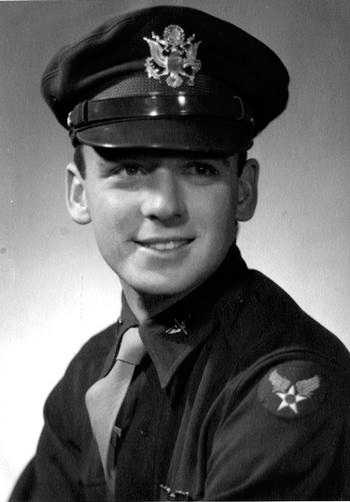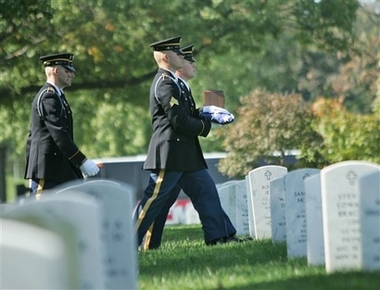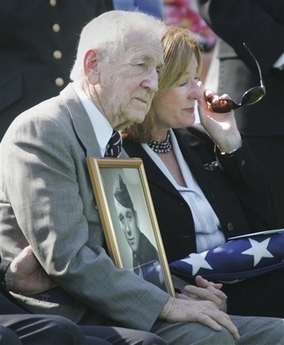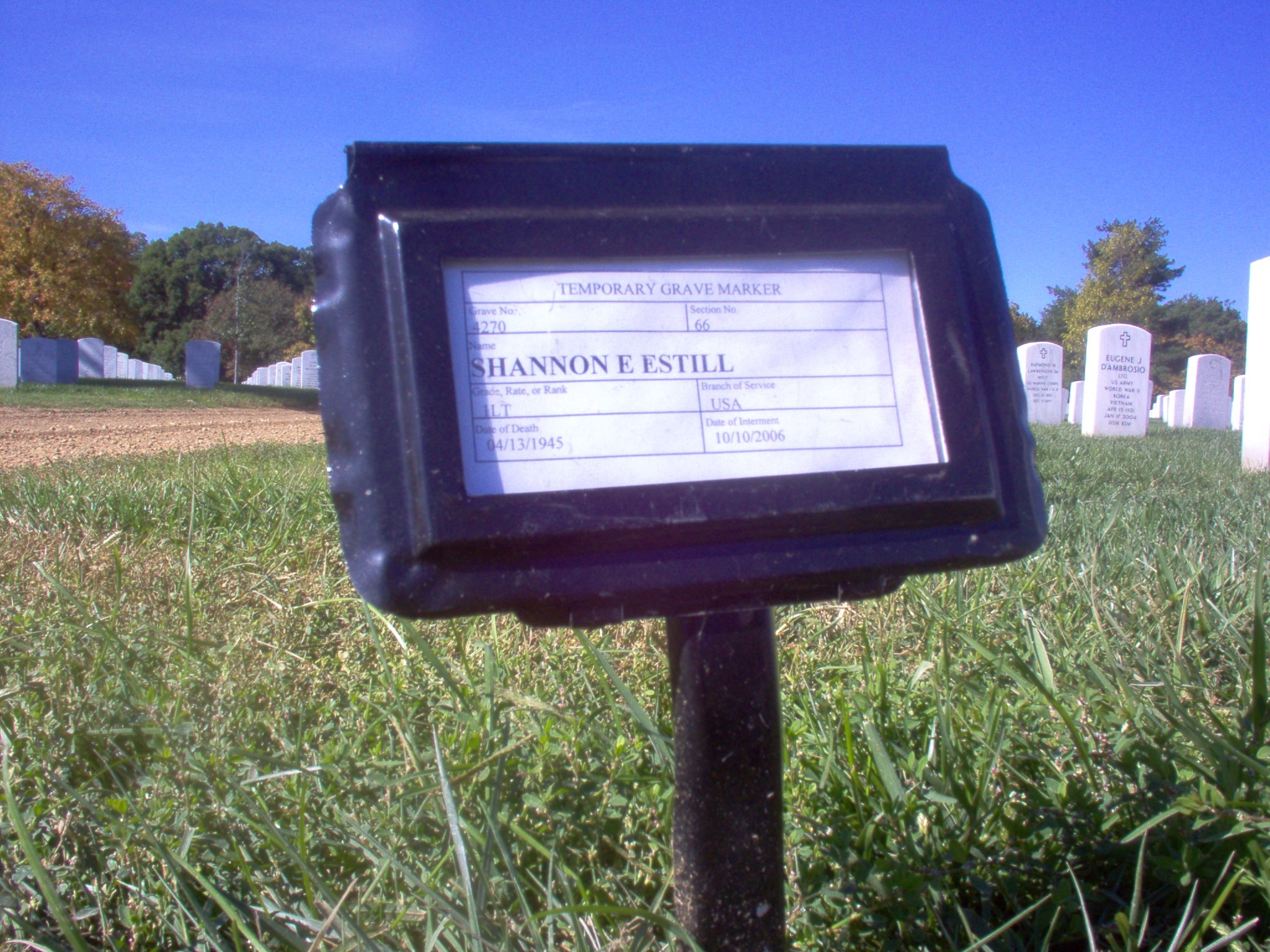Shannon E. Estill
First Lieutenant, U.S. Army Air Forces
Service # O-702781
428th Fighter Squadron, 474th Fighter Group
Entered the Service from: Iowa
Died: 13-Apr-45
Missing in Action or Buried at Sea
Tablets of the Missing at Netherlands American
Cemetery
Margraten, Netherlands
Awards: Air Medal with 3 Oak Leaf Clusters –
Remains Recovered
NEWS RELEASES from the United States Department of Defense
No. 1007-06 IMMEDIATE RELEASE
October 09, 2006
Missing World War II Airmen is Identified
The Department of Defense POW/Missing Personnel Office (DPMO) announced today that the remains of a U.S. serviceman, missing in action from World War II, have been identified and returned to his family for burial with full military honors.
He is First Lieutenant Shannon E. Estill, U.S. Army Air Forces, of Cedar Rapids, Iowa. He will be buried on October 10,2006, in Arlington National Cemetery near Washington, D.C.
On April 13, 1945, Estill’s P-38J Lightning was struck by enemy anti-aircraft fire while attacking targets in eastern Germany. Another U.S. pilot reported seeing Estill’s aircraft explode and crash. Because the location of the crash site was within the Russian-controlled sector of occupied Germany, U.S. military personnel could not recover Estill’s remains after the war.
In 2003, a team from the Joint POW/MIA Accounting Command (JPAC) investigated a crash site near the town of Elsnig in eastern Germany. The site had been reported by two German nationals whose hobby is finding the location of World War II crash sites. They also claimed to have found remains at the site, which they turned over to U.S. Army officials. The team surveyed the site and interviewed two more men who witnessed the crash as children.
In 2005, another JPAC team excavated the crash site and recovered additional human remains as well as P-38 wreckage. Included in the recovered wreckage was an aircraft data plate from Estill’s plane. Among other forensic identification tools and circumstantial evidence, scientists from JPAC and the Armed Forces DNA Identification Laboratory also used mitochondrial DNA in the identification of the remains, matching DNA sequences from a maternal relative.
At Arlington National Cemetery last week, Sharon Taylor of Olympia buried the father she had no memory of.
The funeral ended a years-long search by Taylor, 61, associate professor at Saint Martin’s University, to learn the fate of First Lieutenant Shannon E. Estill of the Army Air Forces during World War II.
Taylor was 3 weeks old when German anti-aircraft fire brought down Estill’s P-38J Lightning fighter plane over eastern Germany on April 13, 1945 – less than a month before the Allied victory over the Axis in Europe. He was 22.
Another U.S. pilot nearby saw Estill’s plane explode and crash in the field below.
U.S. military personnel couldn’t recover his remains because the site was under the control of the Russians after the war. His name was added to those of the many thousands missing somewhere in that ravaged land.
German farmers continued to plow the field, turning the aircraft parts and remains into the dirt.
At home, his young widow, Mary, was stricken with grief and despair that would remain until she uttered her last words at age 59: “Hi, honey, I’ve been waiting …”
His daughter’s love endured, withstanding both time and distance. She would be the one to find him. She would bring him home.
“I felt like I carried that responsibility with me for all the people who never knew what happened to him,” she said.
Her mission became ever more clear when she transcribed the hundreds of letters exchanged by her parents between 1939 and 1945. The work took the bulk of one summer in the early 1990s and produced 3,000 typewritten pages. Her intent was to preserve the words of love and family legacy.
But those words also held clues to her father’s past. The names she found in the letters included her father’s crew chief, whom she located easily. That contact opened the door to the surviving members of her father’s squadron, and soon to a German aircraft researcher, Hans Guenther Ploes, who hunts World War II planes that were shot down in his country. They became allies.
“It just began to happen,” she said.
Momentum builds
In 2001, she made her first trip to Germany, met Ploes and began tracing the last months and days of her father’s life.
She made several more trips to Germany to locate where he had died. After she returned to the United States, the search continued without her and grew to include several members. Ploes never asked for payment, although Taylor would pay for his hotel rooms and his meals when visiting Germany.
On one occasion, Taylor asked Ploes why he was helping her. “Because you asked,” was his reply.
In March 2003, when another war in another part of the world was about to commence, Taylor arrived in Germany to find Ploes with a huge grin on his face.
“He was so excited,” she recalled.
But he wouldn’t tell her the reason for his excitement. It would have to wait until dinner.
He arrived with a strange bundle tucked under his arm. Wrapped under plastic was an airplane part Taylor didn’t recognize with a tiny series of numbers on it.
The number on the part matched the number written on a missing air crew report written by Estill’s squadron leader.
After a long process of elimination, the search team had found the crash site. They found the part and what a team member believed was a human bone fragment.
Upon hearing the news at dinner, Taylor burst into tears.
Lost and found
With hard evidence in hand, Taylor turned to the U.S. government to excavate the site, and recover and identify the remains.
She was able to join and work with a team from the Joint POW/MIA Accounting Command during its second visit to the crash site during a three-week period in August and September 2005. The team recovered additional human remains and wreckage from the P-38J.
“I shoveled,” she said. “I dug in the dirt when I could.”
JPAC cannot prohibit family members from joining the team, but family members are made aware of the risks, including unexploded ordnance and poisonous vermin. And, if they are injured, that could delay recovery of remains, said Larry Greer, a spokesman for the Defense POW/Missing Personnel Office.
“It’s pretty rare,” he said about family members as team members. “However, she had some connections, some acquaintance with the German nationals who were doing the original investigations over there.”
Using DNA testing, JPAC confirmed the remains were of Estill and presented them to Taylor at her Phoenix home in April. She was dividing her time living in Phoenix and a houseboat moored in Budd Inlet.
On Tuesday, the remains buried in foreign soil for decades were placed in hallowed ground at Arlington National Cemetery in Arlington, Va.
Some of the surviving members of Estill’s squadron attended. Sitting next to Taylor was Estill’s 82-year-old brother, Wesley, who clutched a picture of his long-lost older brother to his chest. An Army chaplain presented the folded American flag to her, a symbol of her father’s service and sacrifice.
“I simply wanted to bring him home and go to whatever lengths to do that,” she said.
Search for missing World War II airman closes at Arlington National Cemetery
By Kyle Marksteiner
Courtesy of the Carlsbad Current Argus
18 November 2006
Last month, Wes Estill and his son slowly marched past the endless rows of neat wooden crosses at Arlington National Cemetery. As the funeral procession drew close to the end, a military limousine stopped and Estill’s elderly father, Wesley Boyd Estill, joined in the final stretch of the somber march.
At the end of the journey, Wes and family members said goodbye to a man many of them had known about for years but never met — Shannon E. Estill — a World War II airman shot down over eastern Germany more than 60 years ago.
First Lieutenant Shannon E. Estill, U.S. Army Air Corps, of Cedar Rapids, Iowa, had been identified and returned to his family for burial with full military honors, according to a press release from the Department of Defense POW/ Missing Personnel Office.
The uncle, brother, and, perhaps most of all — father — had come home.
Shannon’s nephew, Wes, 56, works for Los Alamos National Laboratory in Carlsbad. He’s currently working in Los Alamos to prepare shipments of radioactive waste for delivery to the Waste Isolation Pilot Plant near Carlsbad. A technical staff member, Wes has worked for LANL for eight years, and he has spent several years working in Carlsbad.
The true heroine of the saga, however, is Sharon Estill Taylor, 61, who was all of three weeks old when her father was shot down during World War II. Sharon, an associate professor at Saint Martin’s University in Wash., has spent a lifetime searching for her dad.
Her quest began with transcribing hundreds of letters exchanged between her parents during the war. She tracked down members of her father’s chief crew and other men he served with. She eventually met Hans Guenther Ploes, a German aircraft researcher. In 2003, Ploes, along with other members of a search team, discovered Shannon’s remains. The United States military took over and completed the identification and excavation of the remains.
Sharon’s heroic search for her father has been chronicled nationally over the past few months. It is featured at the Arlington Cemetery’s Web site at https://www.arlingtoncemetery.net/seestill.htm, but is certainly most compellingly retold by Taylor herself in her blog at http://www.teamestill.blogspot.com.
For family members, including first cousin Wes, Sharon’s dedication has served as a source of inspiration and pride.
Wesley Boyd and Shannon Estill grew up and attended high school in Cedar Rapids, Iowa. Both boys served in World War II. Shannon, the older, served in the European theater. Wesley served with the Navy in the South Pacific.
Shannon, 22, had married before he left for Europe. His wife, Mary, gave birth to a baby girl — Sharon — while he was overseas.
“We speculate that the two brothers communicated in 1944 and 1945 about their military activities,” Wes, Shannon’s nephew, said. “My dad was on a ship in the Philippines, and we speculate that he would have told his older brother about the massive armada of ships in that battle that ended the Japanese Navy’s control of the Pacific.”
On April 13, 1945, Shannon Estill’s P-38J Lightning aircraft was struck by enemy anti-aircraft fire while attacking targets in eastern Germany. Because the location of the crash site was within the Russian-controlled sector of occupied Germany, according to a military press release, U.S. military personnel could not recover his remains after the war.
Wesley Boyd Estill made it home from his tour in the Pacific theater safely. He moved west after the war. He and his wife had seven children, including Wes.
“We were never in the same place growing up as my cousin,” Wes said. “We were always quite a distance apart. We thought of her as that orphan child who was always waiting for her father to come home. It was sad to talk with her and hear from her. It was a struggle for her and her mother to get back on their feet.”
Even as a child, Wes said, Sharon began searching for her father.
“She thought her father, who was missing in action, would some day walk down the sidewalk and come home,” Wes said. “As an adult, she was so profoundly taken by the experience of being an orphan from a military father that she contacted the squadron my uncle had belonged to. She started entertaining the idea of maybe finding the location of her father’s crash site. She always had a hope that he had bailed out in a parachute.”
Sharon believes her dad knew he was her father before he was shot down.
“She has thousands of pages of correspondence between her mother and father,” Wes said. “She believes her father was aware that he was a new father, but he never met his daughter.”
Sharon’s mother eventually remarried.
“Her mother never did fall out of love with my uncle,” Wes said. “But she did go on with her life.”
Mary died at age 59. Sharon’s quest to find her father and bring him home, however, has continued.
“It has only been very recently that the rest of the family has fully supported her quest,” Wes admitted. “About two years ago, she asked her cousins if we could go with her to Germany to look for her father’s crash site.”
The cousins were not able to make the trip, and Sharon went by herself.
“In large part, we did not accompany her because there is still some strong bitterness in our family about the Germans and World War II,” Wes said. “The thought of going to Germany and looking for our uncle brought on some angry feelings of confrontation.”
Sharon made several trips to Germany. With the help of Ploes and other hobbyists, and eventually the American military, members of the search team discovered a site believed to be the crash site. An identification tag was located, and remains were subsequently uncovered. DNA from the remains matched family members. Search team members interviewed two local German residents who witnessed the crash as children. Sharon assisted with the recovery efforts.
Twenty-two members of the Estill family joined other members of Sharon’s family in attending the Oct. 10 funeral and burial at Arlington National Cemetery. Even on the day of the funeral, Shannon Estill’s name still registered as Missing in Action in the national archive, Wes said.
The U.S. Army Chief of Staff attended the funeral service at the Old Post Chapel in Ft. Myer, Va. The Army Chaplain, as well as the Army Air Corps Chaplain from when Shannon served in the military, delivered eulogies.
“It was a very patriotic and emotional experience,” Wes said. “As a family we were allowed to participate in the procession from the chapel to the gravesite.”
The funeral procession involved a mile walk behind a caisson-wagon pulled by seven black horses. A flag was draped on the casket in the wagon. A military band and honor guard marched ahead.
“There was not a speck of dust on their uniforms,” Wes observed.
Also accompanying the procession were a rifle unit and a single bugler.
“We walked among the 250,000 military dead,” Wes said. “It started with the Civil War. There was so much history.”
Shannon’s brother, Wesley Boyd, had been following the procession in a military limo. Now 83, Wesley has difficulty traveling, Wes said. Earlier, a military officer had given Wesley Boyd a small medal.
About 50 yards from the gravesite, the limo stopped and Wesley Boyd joined his son and grandson for the final leg of the procession. The grandfather clutched an 11 by 14 photograph of his brother, taken in 1943 when Shannon obtained his wings. Wes guided his father to his seat at the burial site.
During the ceremony, two fighter planes flew over the site to memorialize the World War II airman.
“I still have a lump in my throat watching that,” Wes said.
Wes’ most vivid memory of the ceremony at the gravesite was of military officers carefully and slowly folding an American flag. An officer turned to Sharon, kneeled, and offered the flag.
The tempo of the event changed at the celebration that followed the burial, Wes said. The military provided upbeat music and a hearty meal, while Sharon showed a video about her father and mother based on pictures and love letters she’d inherited.
In the spring, Wes said, Sharon will take a final trip to Germany to watch as a gold star is placed next to her father’s name on a memorial listing him as missing in action, indicating that the soldier has been found.
Wes plans to join his cousin.
“As they say these days She has found closure,'” Wes said. “What does that mean? To me it means she can go on with her life. We noticed that there is finality in her quest. She is satisfied that she did everything she could as a daughter to bring her father home.”
The chance to share in her farewell will likely be something the other members of the Estill family will never forget.
“Sharon was walking with me beside the caisson at Arlington along with her husband and grandchildren. I walked with her with my son,” Wes said. “It was such an overwhelming experience as we were walking down the rows and rows of tombstones. I actually thought we would see old Marines and old soldiers get up from the grave and salute as we walked by. I thought they were saying to this newfound member of the military Welcome home .’:
The remains of a World War II U.S. serviceman Army Airman First Lieutenant Shannon Estill, of Cedar Rapids, Iowa, are carried during funeral services at Arlington National Cemetery, Tuesday, October 10, 2006. According to the Defense Department, Estill’s P-38J Lightning was struck by enemy nti-aircraft fire while attacking targets in eastern Germany on April 13, 1945. His remains were recently discovered at a crash site near the town of Elsnig in eastern Germany.
Sharon Estill Taylor, daughter of World War II U.S. serviceman Army Airman First Lieuenant Shannon Estill, right, and her uncle, Wesley Estill, take part in 1st Lt. Estill’s funeral services at Arlington National Cemetery in Arlington, Va., Tuesday, Oct.. 10, 2006. According to the Defense Department, Estill’s P-38J Lightning was struck by enemy anti-aircraft fire while attacking targets in eastern Germany on April 13, 1945. Estill’s remains were recently discovered at a crash site near the town of Elsnig in eastern Germany.
ESTILL, SHANNON EUGENE
- 1LT US ARMY
- WORLD WAR II
- DATE OF BIRTH: 06/26/1922
- DATE OF DEATH: 04/13/1945
- BURIED AT: SECTION 66 SITE 4270
ARLINGTON NATIONAL CEMETERY
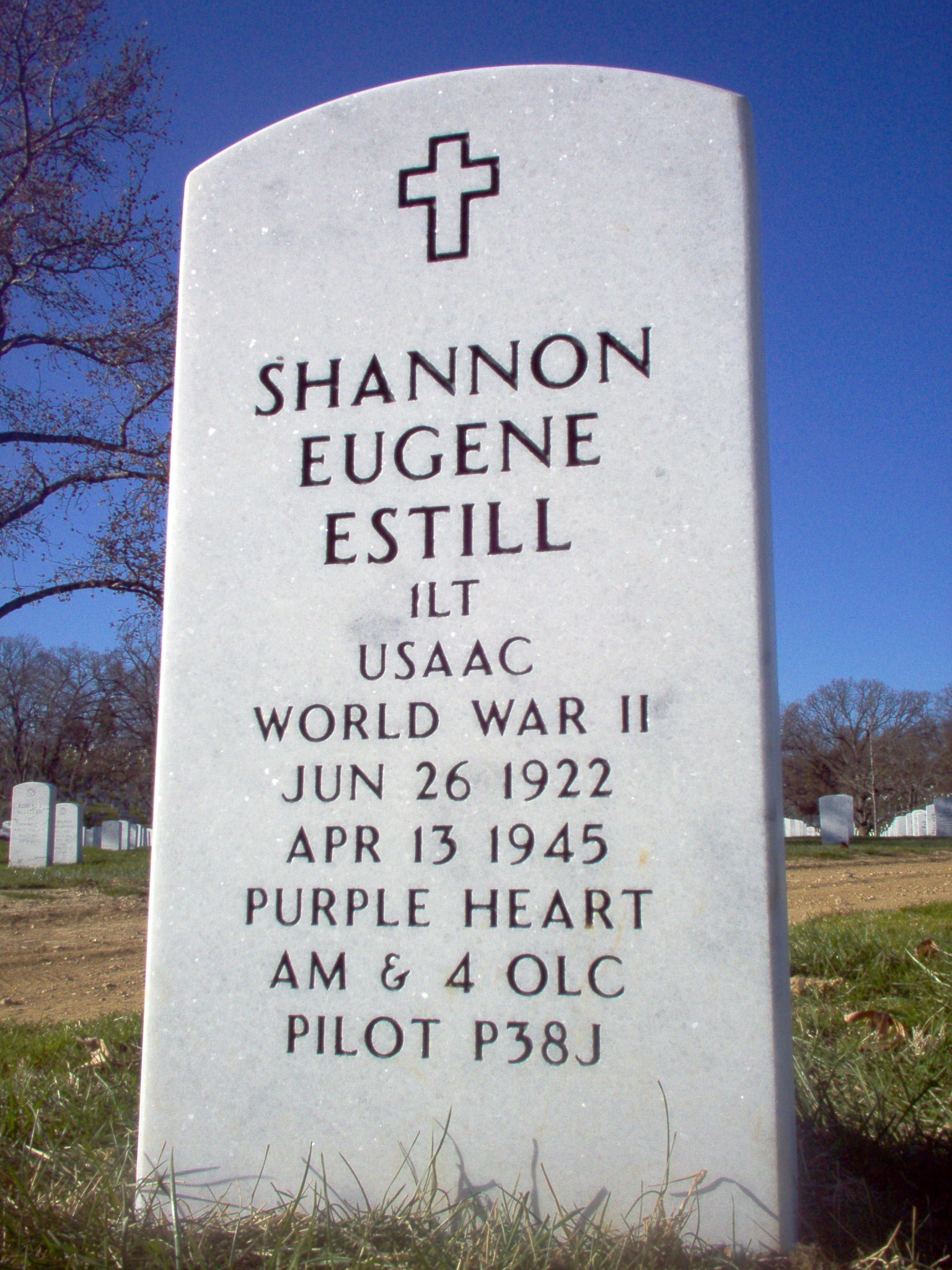
Michael Robert Patterson was born in Arlington and is the son of a former officer of the US Army. So it was no wonder that sooner or later his interests drew him to American history and especially to American military history. Many of his articles can be found on renowned portals like the New York Times, Washingtonpost or Wikipedia.
Reviewed by: Michael Howard

